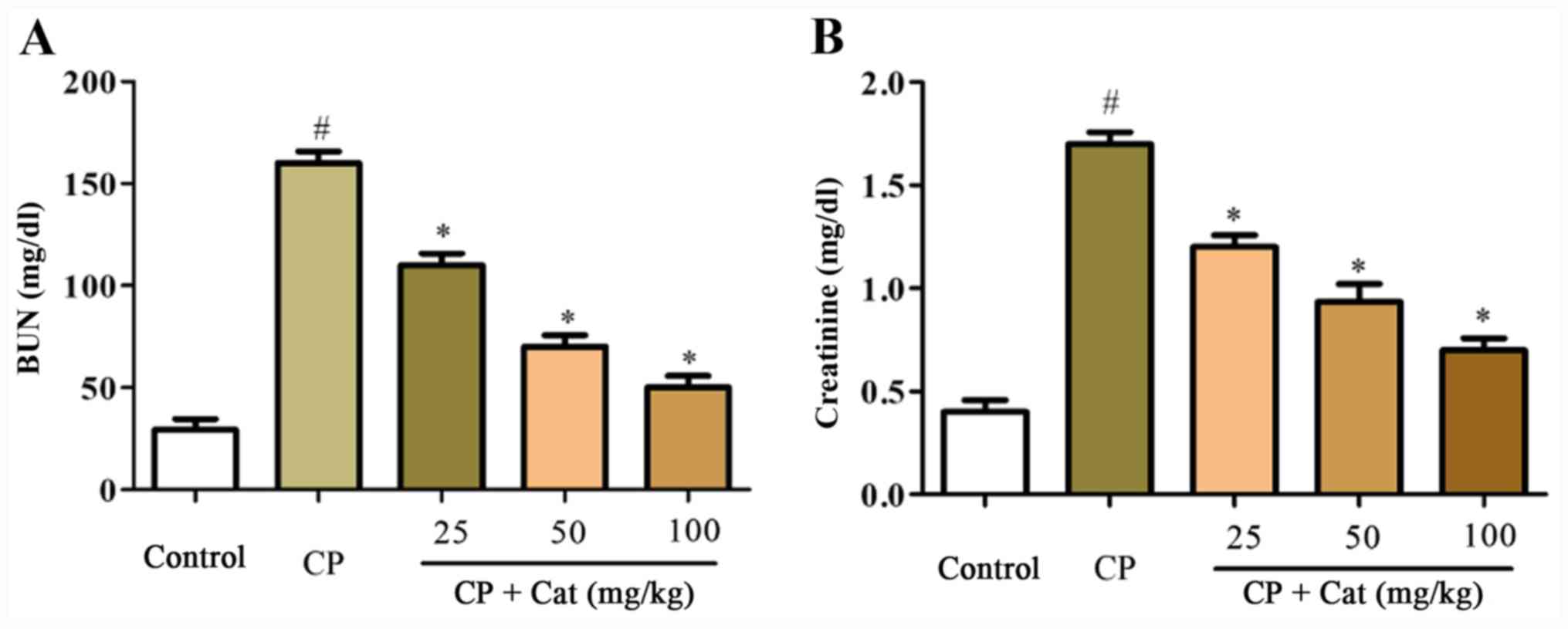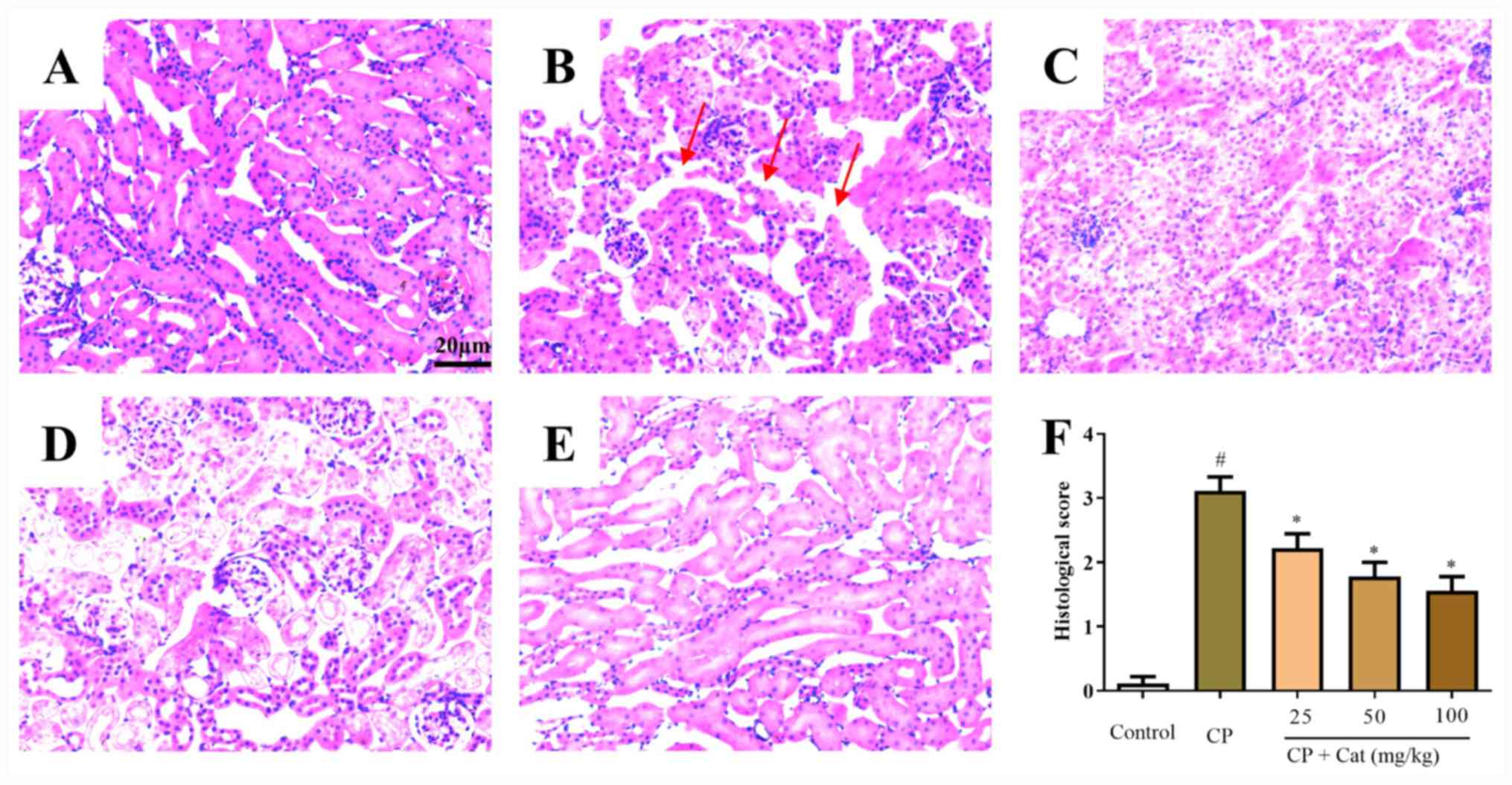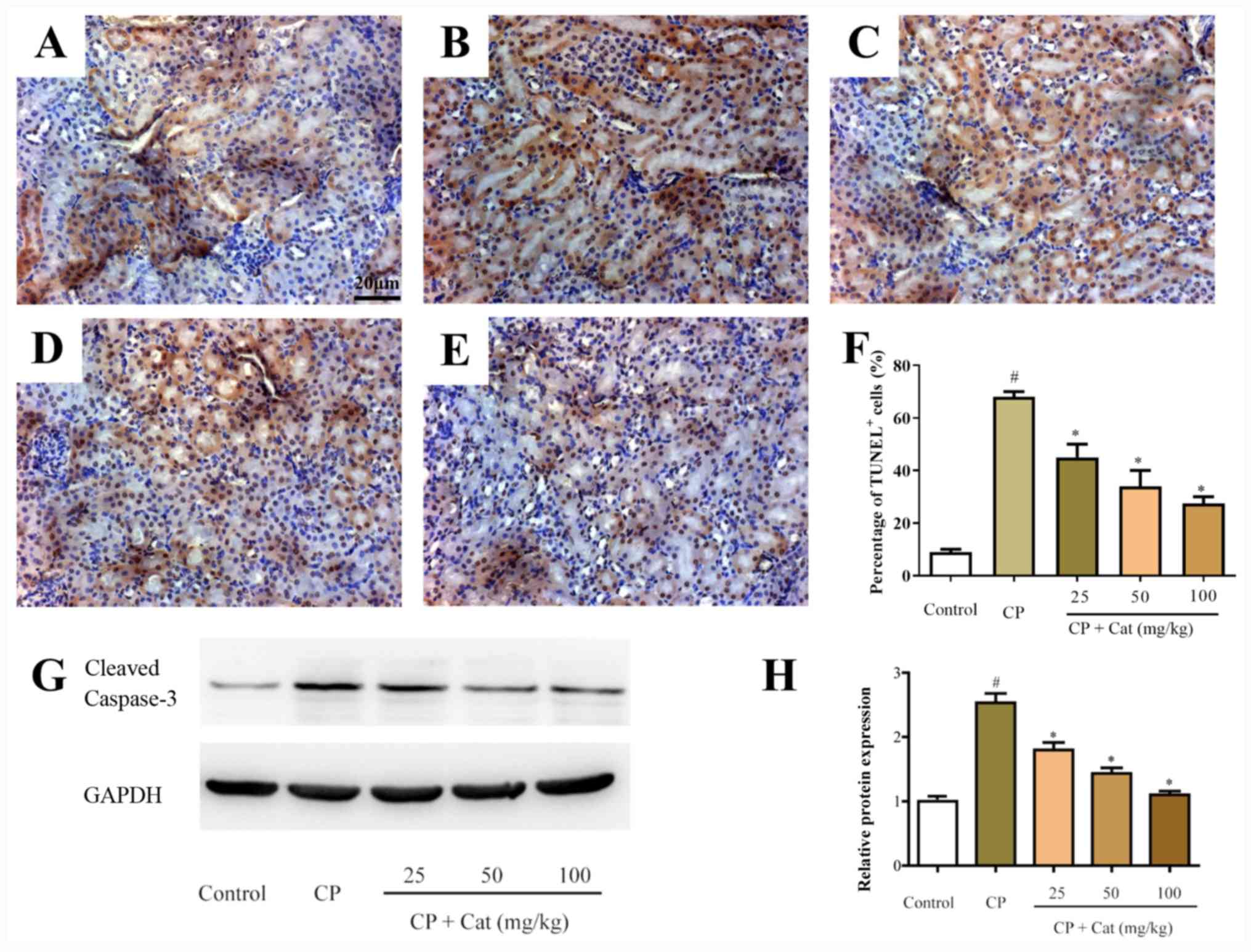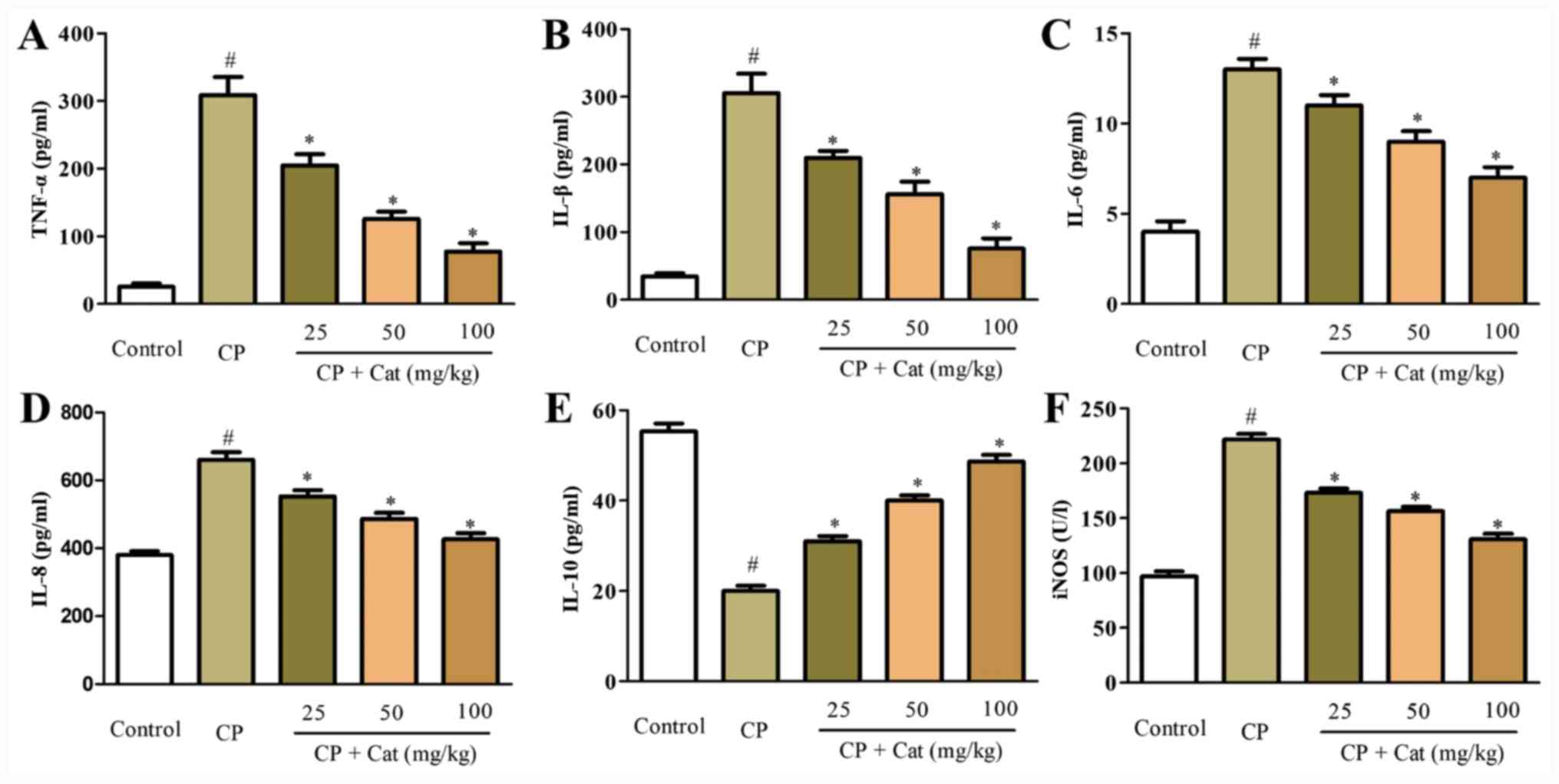|
1
|
Jiang Y, Jiang J, Jia H, Qiao Z and Zhang
J: Recovery of miR-139-5p in ovarian cancer reverses cisplatin
resistance by targeting c-Jun. Cell Physiol Biochem. 51:129–141.
2018.PubMed/NCBI View Article : Google Scholar
|
|
2
|
Du A, Jiang Y and Fan C: NDRG1
downregulates ATF3 and inhibits cisplatin-induced cytotoxicity in
lung cancer A549 cells. Int J Med Sci. 15:1502–1507.
2018.PubMed/NCBI View Article : Google Scholar
|
|
3
|
Xu B, Zeng M, Zeng J, Feng J and Yu L:
Meta-analysis of clinical trials comparing the efficacy and safety
of liposomal cisplatin versus conventional nonliposomal cisplatin
in nonsmall cell lung cancer (NSCLC) and squamous cell carcinoma of
the head and neck (SCCHN). Medicine (Baltimore).
97(e13169)2018.PubMed/NCBI View Article : Google Scholar
|
|
4
|
Anari F, O'Neill J, Choi W, Chen DYT,
Haseebuddin M, Kutikov A, Dulaimi E, Alpaugh RK, Devarajan K,
Greenberg RE, et al: Neoadjuvant dose-dense gemcitabine and
cisplatin in muscle-invasive bladder cancer: results of a phase 2
trial. Eur Urol Oncol. 1:54–60. 2018.PubMed/NCBI View Article : Google Scholar
|
|
5
|
Santiago MJ, Fernández SN, Lázaro A,
González R, Urbano J, López J, Solana MJ, Toledo B, Del Castillo J,
Tejedor A, et al: Correction: Cisplatin-induced non-oliguric acute
kidney injury in a pediatric experimental animal model in piglets.
PLoS One. 13(e0207547)2018.PubMed/NCBI View Article : Google Scholar
|
|
6
|
Zhang W, Hou J, Yan X, Leng J, Li R, Zhang
J, Xing J, Chen C, Wang Z and Li W: Platycodon grandiflorum
saponins ameliorate cisplatin-induced acute nephrotoxicity through
the NF-κB-mediated inflammation and PI3K/Akt/apoptosis signaling
pathways. Nutrients. 10(10)2018.PubMed/NCBI View Article : Google Scholar
|
|
7
|
Ye J, Ren Y, Wei Z, Peng J, Chen C, Song
W, Tan M, He Y and Yuan Y: Nephrotoxicity and long-term survival
investigations for patients with peritoneal carcinomatosis using
hyperthermic intraperitoneal chemotherapy with cisplatin: A
retrospective cohort study. Surg Oncol. 27:456–461. 2018.PubMed/NCBI View Article : Google Scholar
|
|
8
|
Li F, Yao Y, Huang H, Hao H and Ying M:
Xanthohumol attenuates cisplatin-induced nephrotoxicity through
inhibiting NF-κB and activating Nrf2 signaling pathways. Int
Immunopharmacol. 61:277–282. 2018.PubMed/NCBI View Article : Google Scholar
|
|
9
|
Alibakhshi T, Khodayar MJ, Khorsandi L,
Rashno M and Zeidooni L: Protective effects of zingerone on
oxidative stress and inflammation in cisplatin-induced rat
nephrotoxicity. Biomed Pharmacother. 105:225–232. 2018.PubMed/NCBI View Article : Google Scholar
|
|
10
|
Yenuganti VR, Ravinder R and Singh D:
Conjugated linoleic acids attenuate LPS-induced pro-inflammatory
gene expression by inhibiting the NF-κB translocation through PPARγ
in buffalo granulosa cells. Am J Reprod Immunol. 72:296–304.
2014.PubMed/NCBI View Article : Google Scholar
|
|
11
|
Potočnjak I, Broznić D, Kindl M, Kropek M,
Vladimir-Knežević S and Domitrović R: Stevia and stevioside protect
against cisplatin nephrotoxicity through inhibition of ERK1/2,
STAT3, and NF-κB activation. Food Chem Toxicol. 107 (Pt A):215–225.
2017.PubMed/NCBI View Article : Google Scholar
|
|
12
|
Kim IH, Kwon MJ, Jung JH and Nam TJ:
Protein extracted from Porphyra yezoensis prevents
cisplatin-induced nephrotoxicity by downregulating the MAPK and
NF-κB pathways. Int J Mol Med. 41:511–520. 2018.PubMed/NCBI View Article : Google Scholar
|
|
13
|
Yu X, Meng X, Xu M, Zhang X, Zhang Y, Ding
G, Huang S, Zhang A and Jia Z: Celastrol ameliorates cisplatin
nephrotoxicity by inhibiting NF-κB and improving mitochondrial
function. EBioMedicine. 36:266–280. 2018.PubMed/NCBI View Article : Google Scholar
|
|
14
|
Polat EC, Besiroglu H, Ozcan L, Otunctemur
A, Eruyar AT, Somay A, Ozbay N, Cekmen M, Eraldemir C and Ozbek E:
Beneficial effects of Oltipraz, nuclear factor - erythroid - 2 -
related factor 2 (Nrf2), on renal damage in unilateral ureteral
obstruction rat model. Int Braz J Urol. 44:1243–1251.
2018.PubMed/NCBI View Article : Google Scholar
|
|
15
|
Zúñiga-Toalá A, Zatarain-Barrón ZL,
Hernández-Pando R, Negrette-Guzmán M, Huerta-Yepez S, Torres I,
Pinzón E, Tapia E and Pedraza-Chaverri J: Nordihydroguaiaretic acid
induces Nrf2 nuclear translocation in vivo and attenuates renal
damage and apoptosis in the ischemia and reperfusion model.
Phytomedicine. 20:775–779. 2013.PubMed/NCBI View Article : Google Scholar
|
|
16
|
Kwak M, Yu K, Lee PC and Jin JO:
Rehmannia glutinosa polysaccharide functions as a mucosal
adjuvant to induce dendritic cell activation in mediastinal lymph
node. Int J Biol Macromol. 120 (Pt B):1618–1623. 2018.PubMed/NCBI View Article : Google Scholar
|
|
17
|
Dai X, Su S, Cai H, Wei D, Yan H, Zheng T,
Zhu Z, Shang EX, Guo S, Qian D, et al: Protective effects of total
glycoside from Rehmannia glutinosa leaves on diabetic
nephropathy rats via regulating the metabolic profiling and
modulating the TGF-β1 and Wnt/β-catenin signaling pathway. Front
Pharmacol. 9(1012)2018.PubMed/NCBI View Article : Google Scholar
|
|
18
|
Zhou Y, Yang K, Zhang D, Duan H, Liu Y and
Guo M: Metabolite accumulation and metabolic network in developing
roots of Rehmannia glutinosa reveals its root developmental
mechanism and quality. Sci Rep. 8(14127)2018.PubMed/NCBI View Article : Google Scholar
|
|
19
|
Zhang H, Jia R, Wang F, Qiu G, Qiao P, Xu
X and Wu D: Catalpol protects mice against
Lipopolysaccharide/D-galactosamine-induced acute liver injury
through inhibiting inflammatory and oxidative response. Oncotarget.
9:3887–3894. 2017.PubMed/NCBI View Article : Google Scholar
|
|
20
|
Liu Z, Zhu P, Zhang L, Xiong B, Tao J,
Guan W, Li C, Chen C, Gu J, Duanmu J, et al: Autophagy inhibition
attenuates the induction of anti-inflammatory effect of catalpol in
liver fibrosis. Biomed Pharmacother. 103:1262–1271. 2018.PubMed/NCBI View Article : Google Scholar
|
|
21
|
Han Y, Shen M, Tang LY, Tan G, Yang QC, Ye
L, Ye LH, Jiang N, Gao GP and Shao Y: Antiangiogenic effects of
catalpol on rat corneal neovascularization. Mol Med Rep.
17:2187–2194. 2018.PubMed/NCBI View Article : Google Scholar
|
|
22
|
Hu LA, Sun YK, Zhang HS, Zhang JG and Hu
J: Catalpol inhibits apoptosis in hydrogen peroxide-induced cardiac
myocytes through a mitochondrial-dependent caspase pathway. Biosci
Rep. 36(36)2016.PubMed/NCBI View Article : Google Scholar
|
|
23
|
Yan J, Wang C, Jin Y, Meng Q, Liu Q, Liu
Z, Liu K and Sun H: Catalpol ameliorates hepatic insulin resistance
in type 2 diabetes through acting on AMPK/NOX4/PI3K/AKT pathway.
Pharmacol Res. 130:466–480. 2018.PubMed/NCBI View Article : Google Scholar
|
|
24
|
Xiao WQ, Yin GJ, Fan YT, Qiu L, Cang XF,
Yu G, Hu YL, Xing M, Wu DQ, Wang XP, et al: Catalpol ameliorates
sodium taurocholate-induced acute pancreatitis in rats via
inhibiting activation of nuclear factor kappa B. Int J Mol Sci.
15:11957–11972. 2014.PubMed/NCBI View Article : Google Scholar
|
|
25
|
Livak KJ and Schmittgen TD: Analysis of
relative gene expression data using real-time quantitative PCR and
the 2(-Delta Delta C(T)) method. Methods. 25:402–408.
2001.PubMed/NCBI View Article : Google Scholar
|
|
26
|
Mohri J, Katada C, Ueda M, Sugawara M,
Yamashita K, Moriya H, Komori S, Hayakawa K, Koizumi W and Atsuda
K: Predisposing factors for chemotherapy-induced nephrotoxicity in
patients with advanced esophageal cancer who received combination
chemotherapy with docetaxel, cisplatin, and 5-fluorouracil. J
Transl Int Med. 6:32–37. 2018.PubMed/NCBI View Article : Google Scholar
|
|
27
|
Lee D, Yu JS, Lee SR, Hwang GS, Kang KS,
Park JG, Kim HY, Kim KH and Yamabe N: Beneficial Effects of
Bioactive Compounds in Mulberry Fruits against Cisplatin-Induced
Nephrotoxicity. Int J Mol Sci. 19(19)2018.PubMed/NCBI View Article : Google Scholar
|
|
28
|
Wang SW, Xu Y, Weng YY, Fan XY, Bai YF,
Zheng XY, Lou LJ and Zhang F: Astilbin ameliorates
cisplatin-induced nephrotoxicity through reducing oxidative stress
and inflammation. Food Chem Toxicol. 114:227–236. 2018.PubMed/NCBI View Article : Google Scholar
|
|
29
|
Mitazaki S, Hashimoto M, Matsuhashi Y,
Honma S, Suto M, Kato N, Nakagawasai O, Tan-No K, Hiraiwa K,
Yoshida M, et al: Interleukin-6 modulates oxidative stress produced
during the development of cisplatin nephrotoxicity. Life Sci.
92:694–700. 2013.PubMed/NCBI View Article : Google Scholar
|
|
30
|
Lee JW, Nam WJ, Han MJ, Shin JH, Kim JG,
Kim SH, Kim HR and Oh DJ: Role of IL-1α in cisplatin-induced acute
renal failure in mice. Korean J Intern Med. 26:187–194.
2011.PubMed/NCBI View Article : Google Scholar
|
|
31
|
Kim WS, Kim H, Kwon KW, Im SH, Lee BR, Ha
SJ and Shin SJ: Cisplatin induces tolerogenic dendritic cells in
response to TLR agonists via the abundant production of IL-10,
thereby promoting Th2- and Tr1-biased T-cell immunity. Oncotarget.
7:33765–33782. 2016.PubMed/NCBI View Article : Google Scholar
|
|
32
|
Tadagavadi RK and Reeves WB: Endogenous
IL-10 attenuates cisplatin nephrotoxicity: Role of dendritic cells.
J Immunol. 185:4904–4911. 2010.PubMed/NCBI View Article : Google Scholar
|
|
33
|
Lee D, Lee DS, Jung K, Hwang GS, Lee HL,
Yamabe N, Lee HJ, Eom DW, Kim KH and Kang KS: Protective effect of
ginsenoside Rb1 against tacrolimus-induced apoptosis in renal
proximal tubular LLC-PK1 cells. J Ginseng Res. 42:75–80.
2018.PubMed/NCBI View Article : Google Scholar
|
|
34
|
Mahran YF: New insights into the
protection of growth hormone in cisplatin-induced nephrotoxicity:
The impact of IGF-1 on the Keap1-Nrf2/HO-1 signaling. Life Sci.
253(117581)2020.PubMed/NCBI View Article : Google Scholar
|














